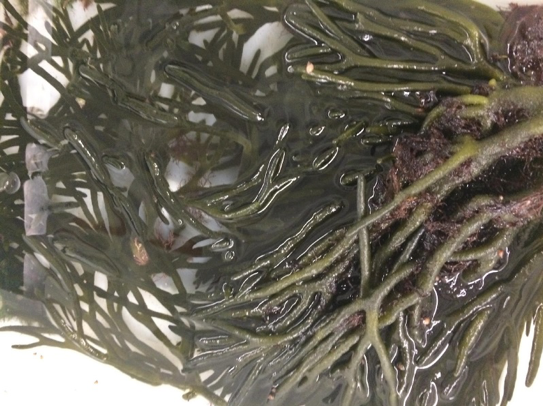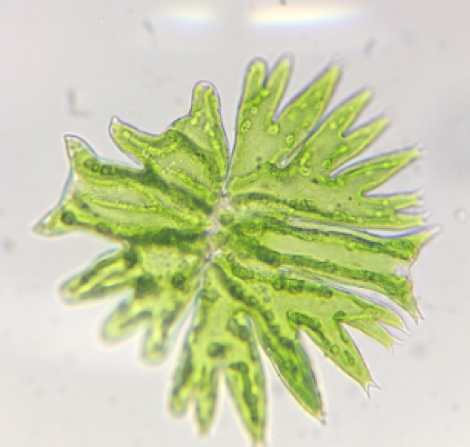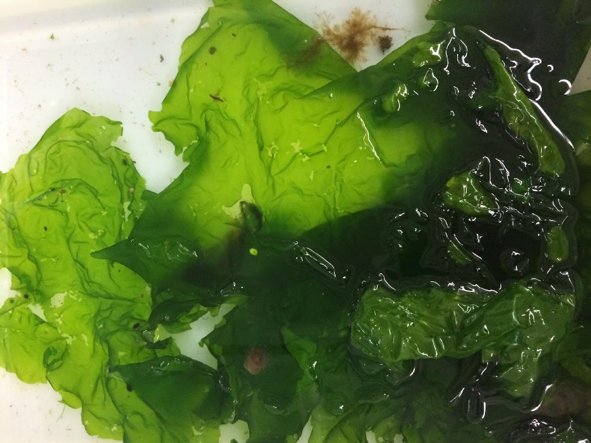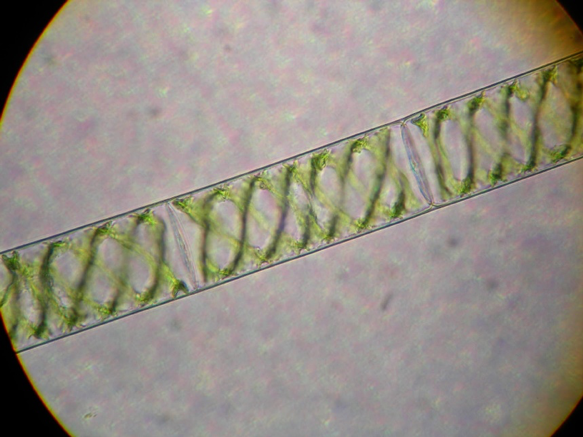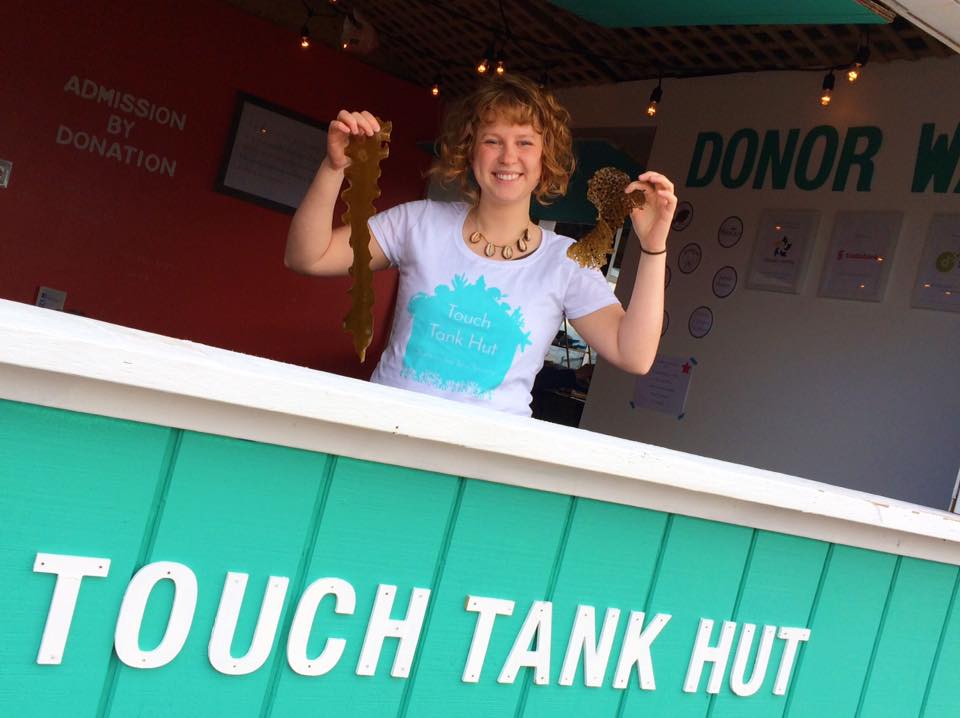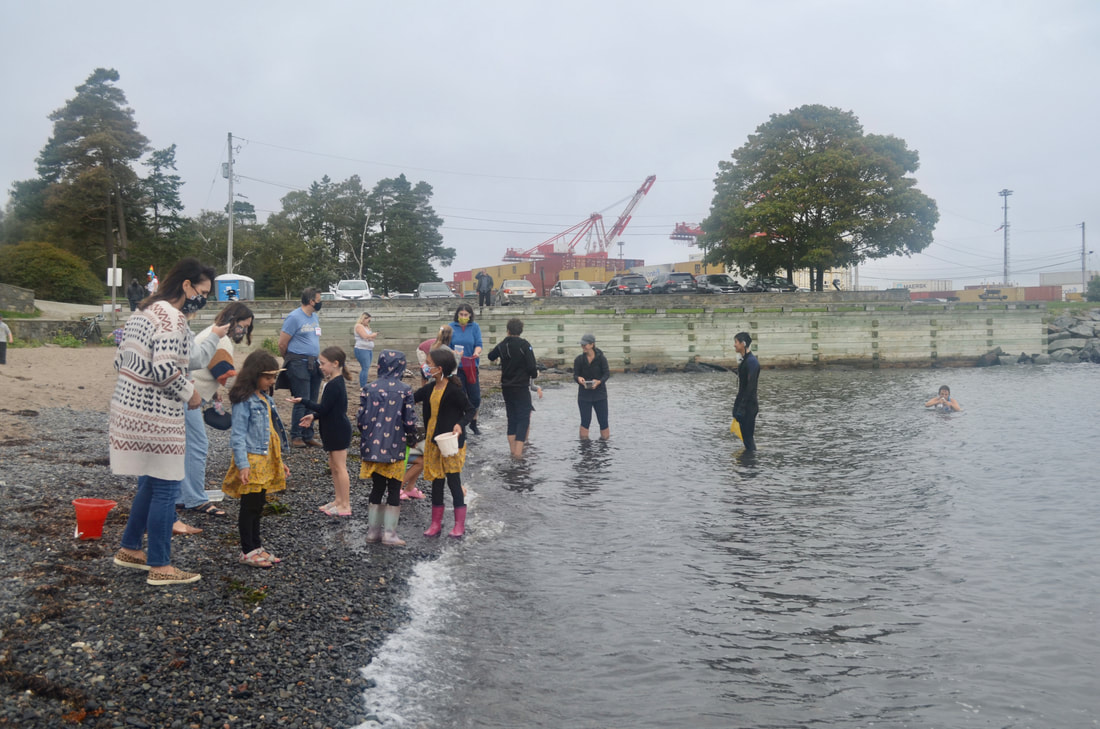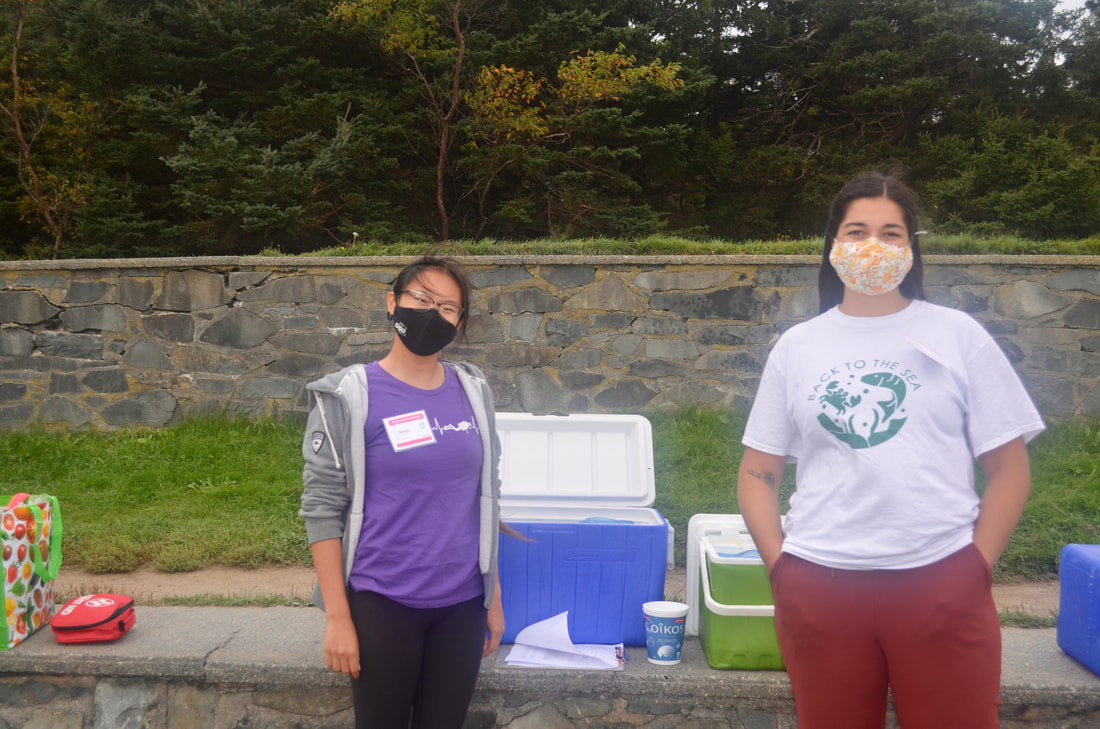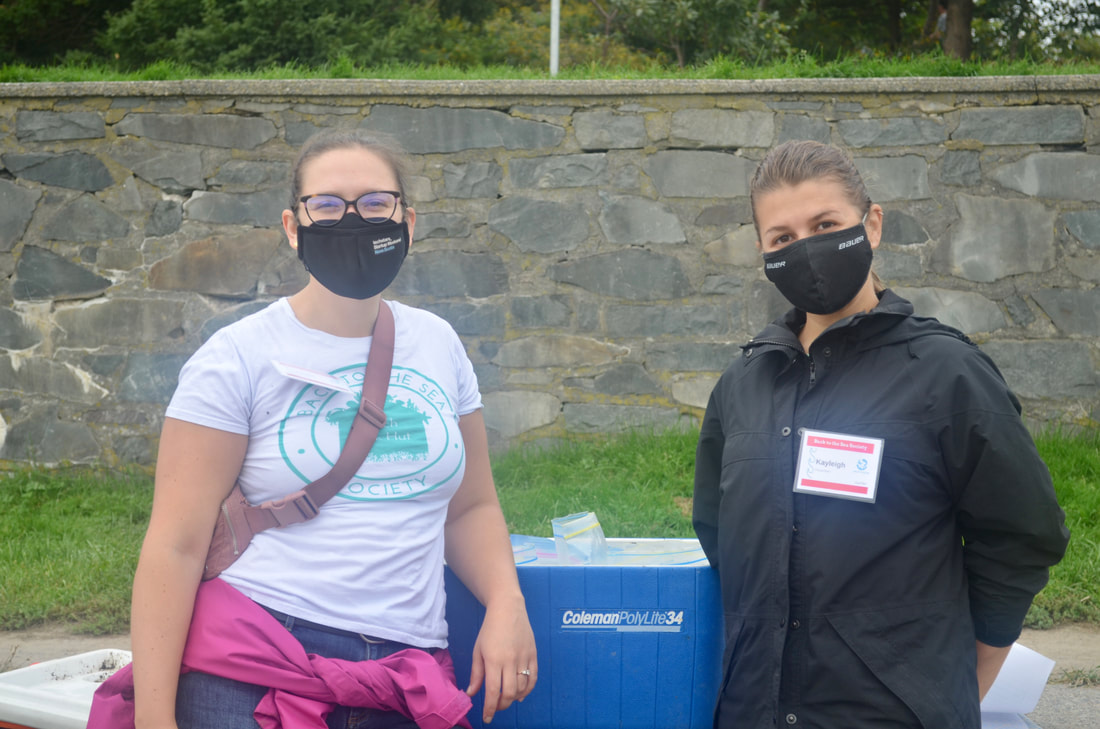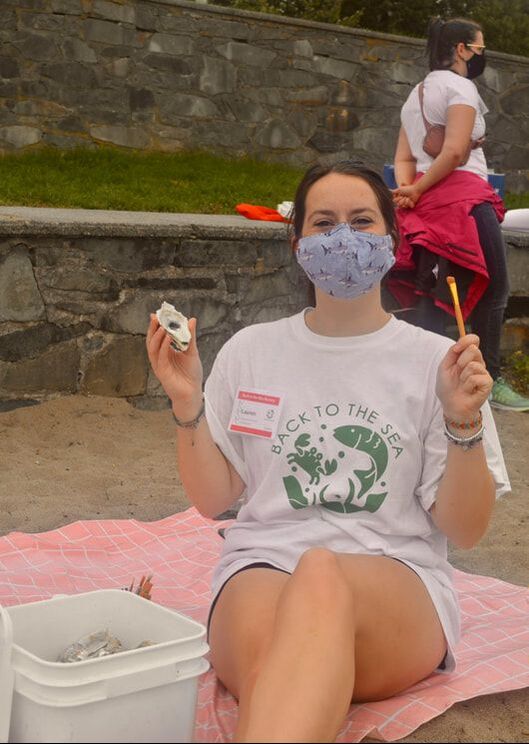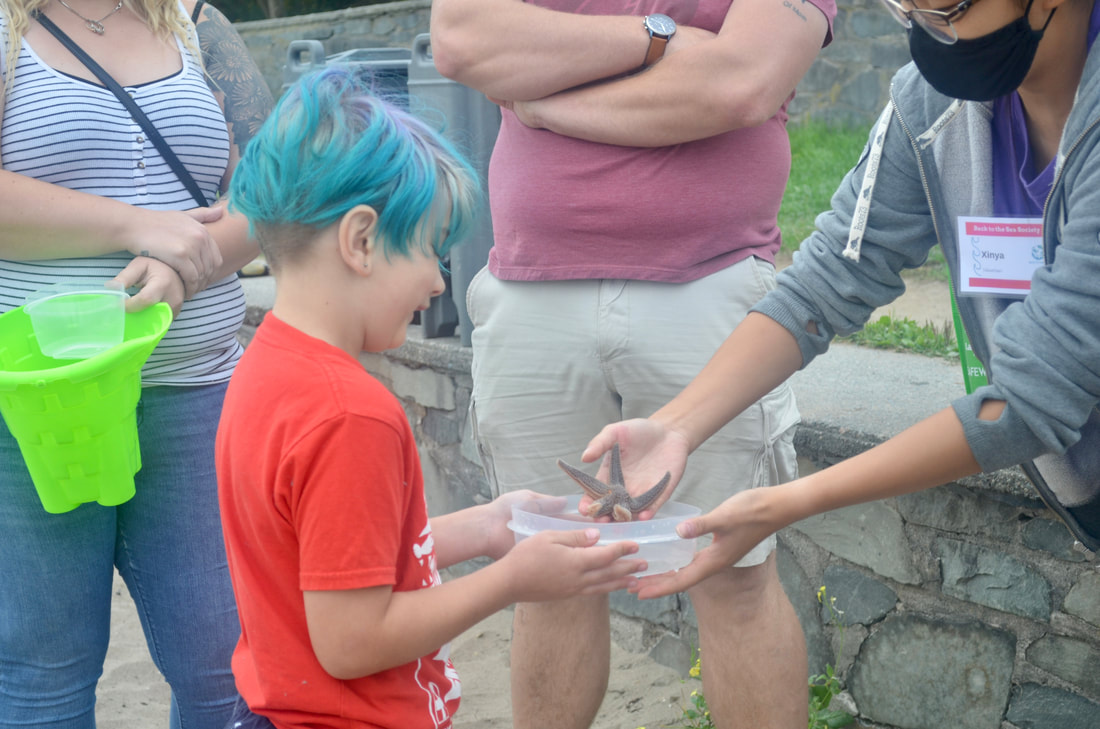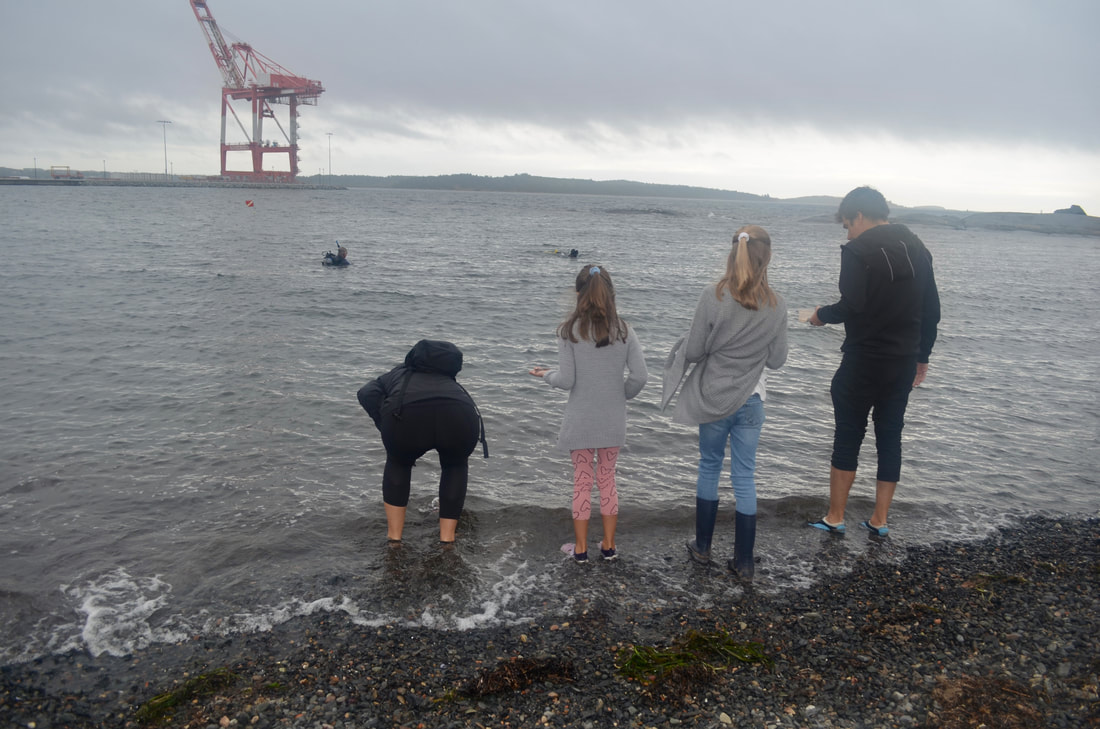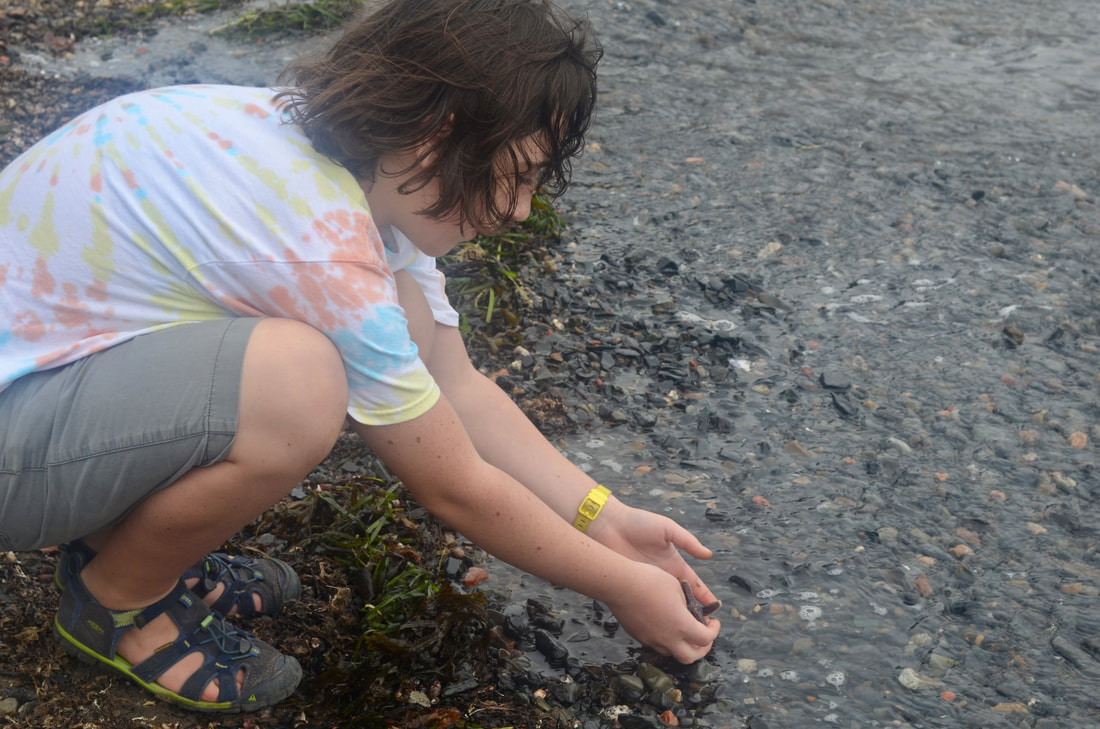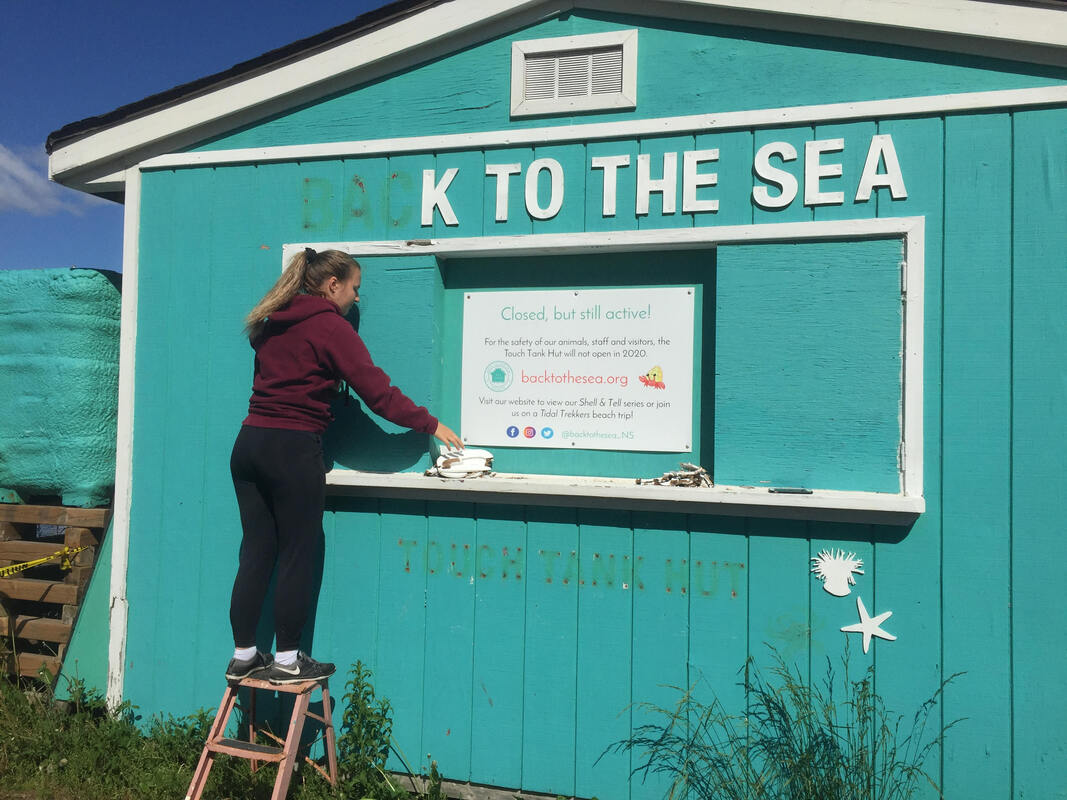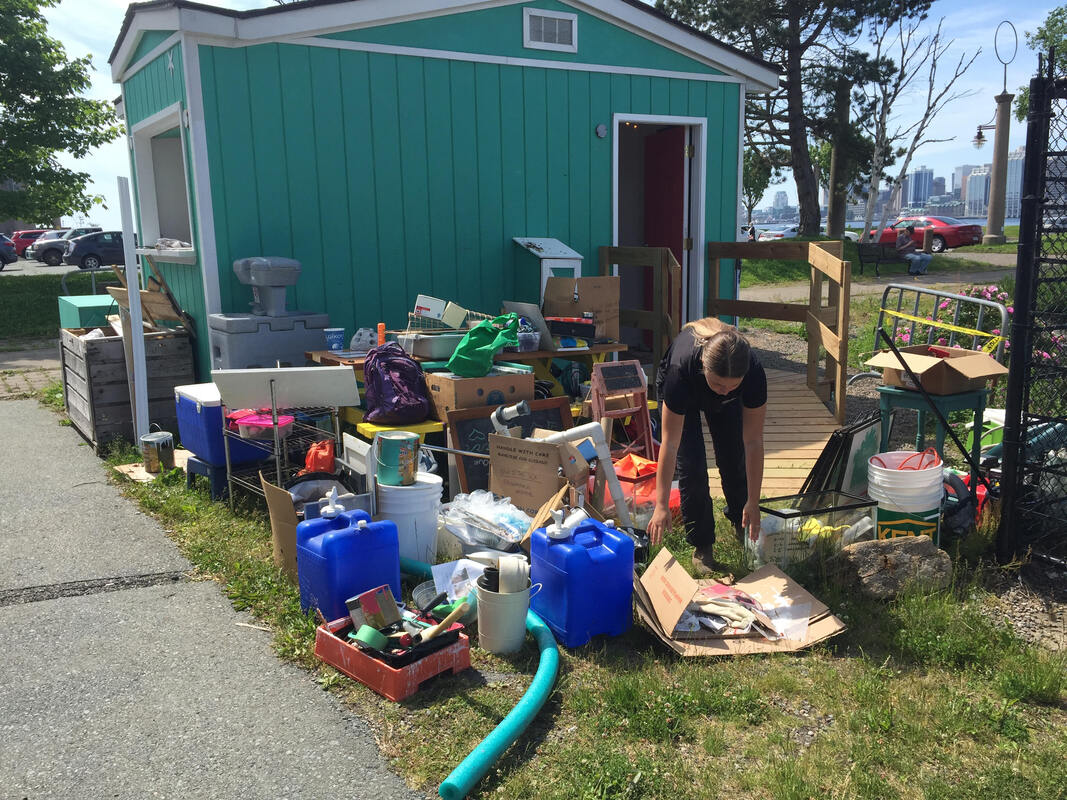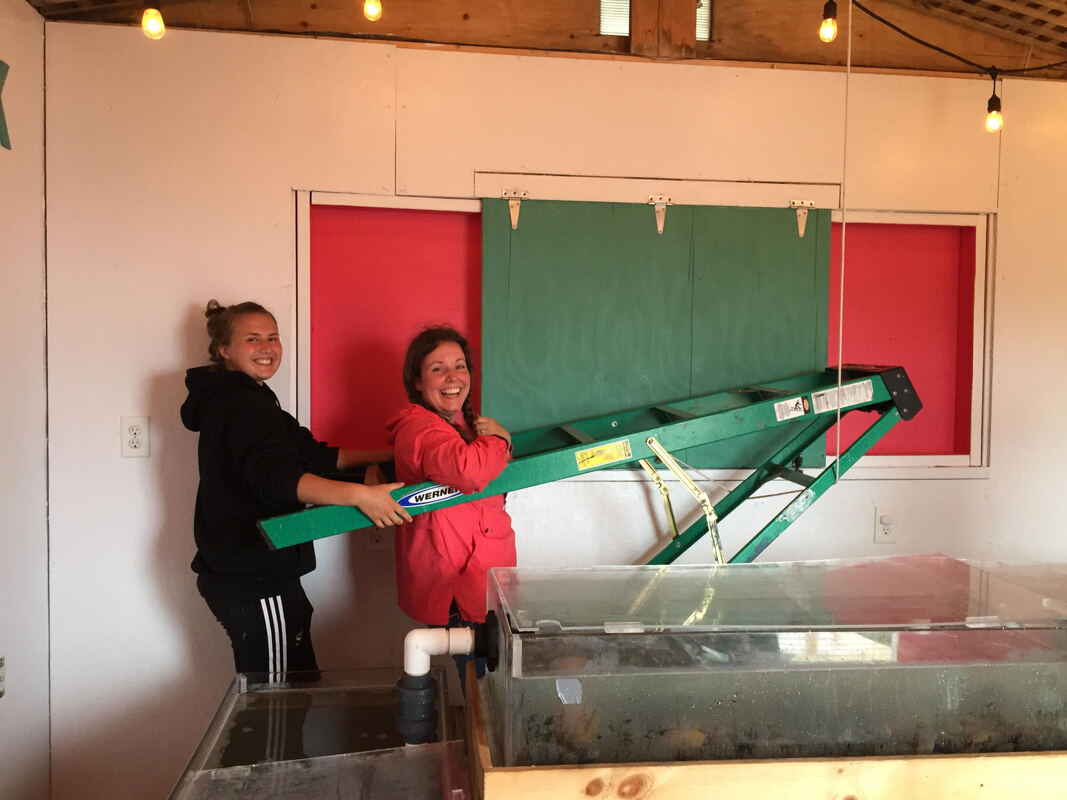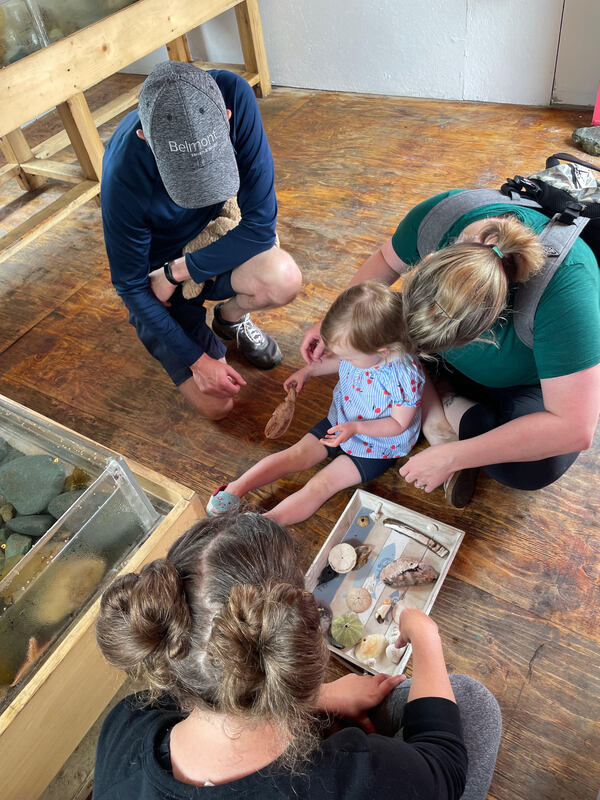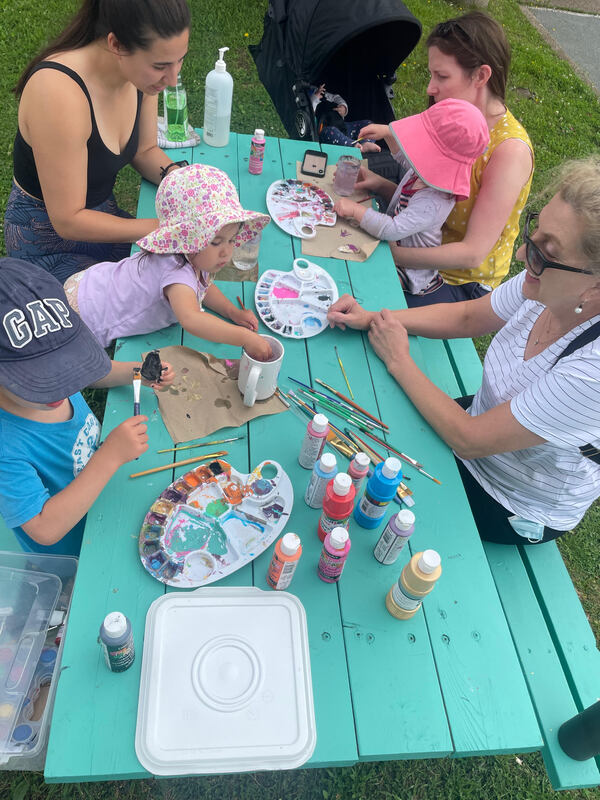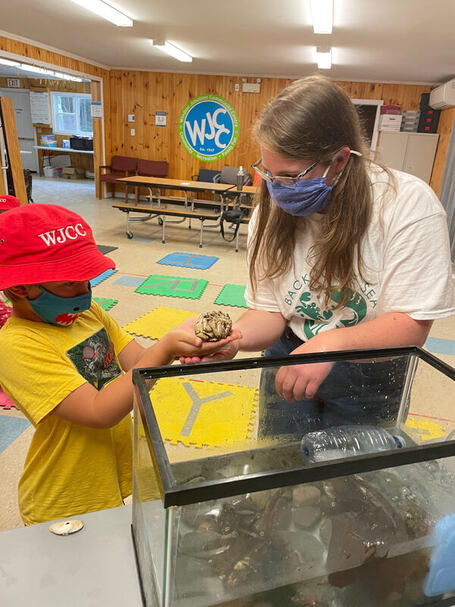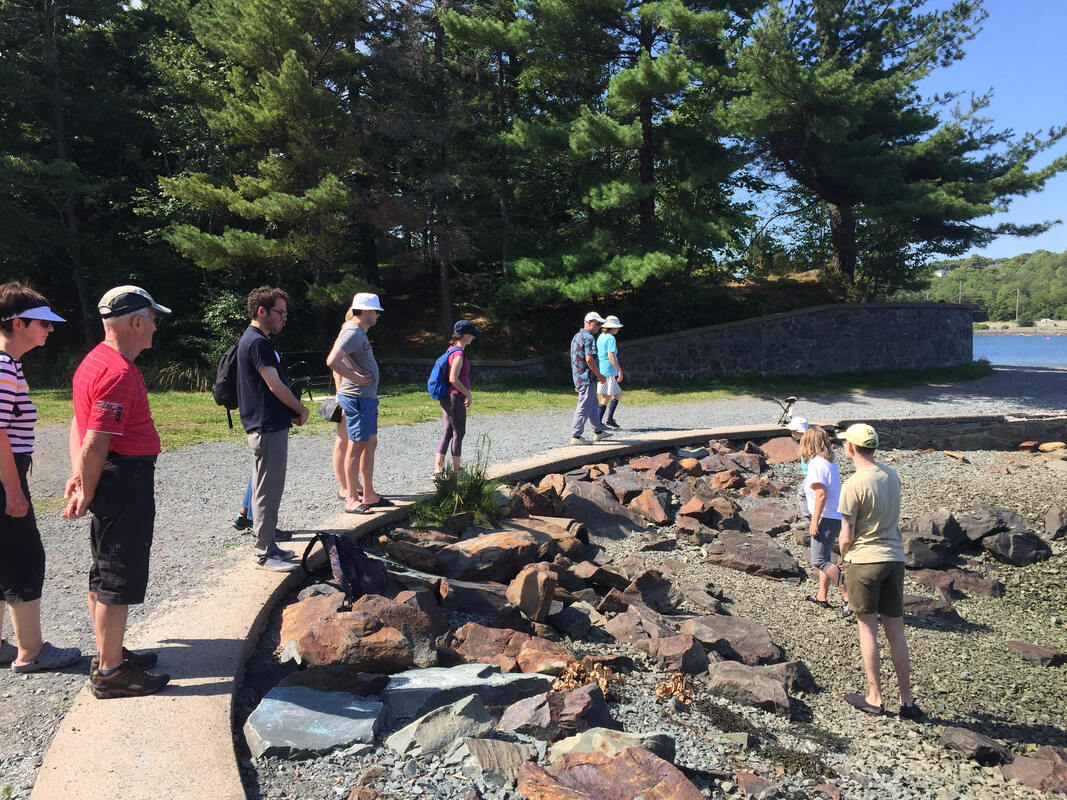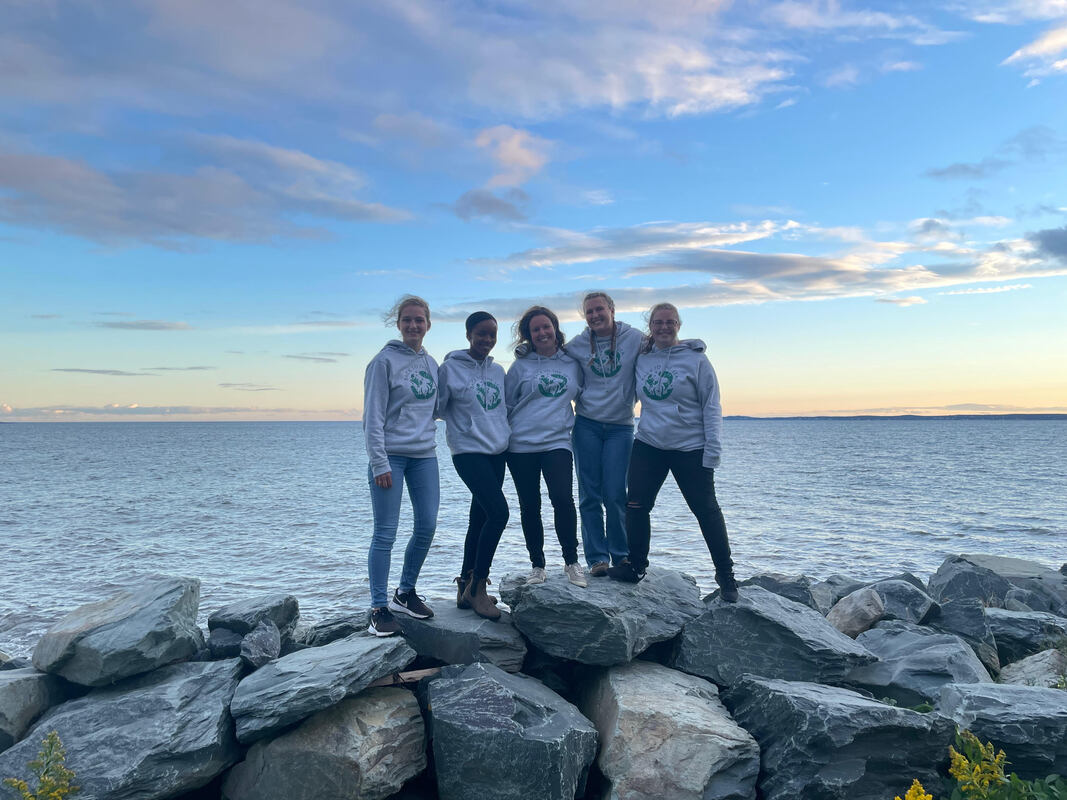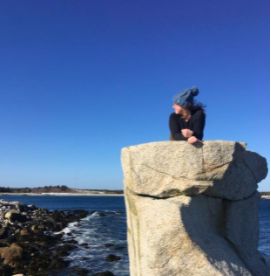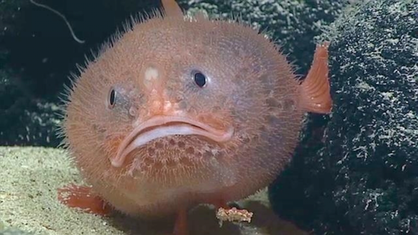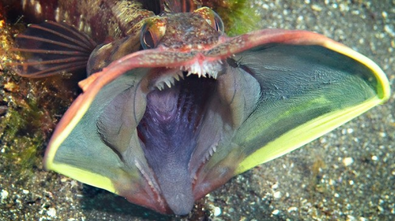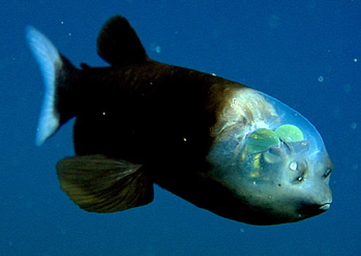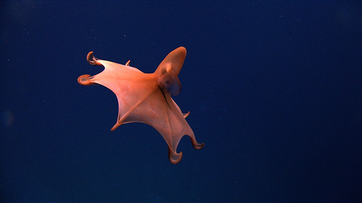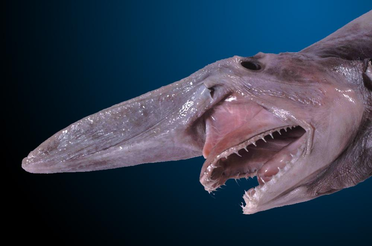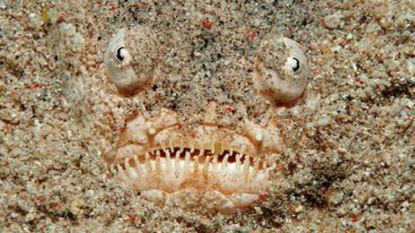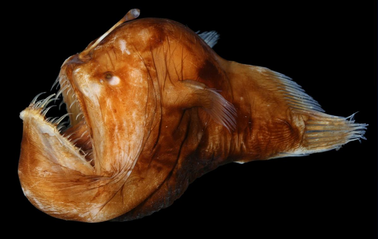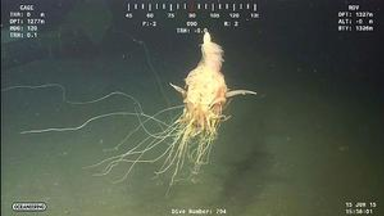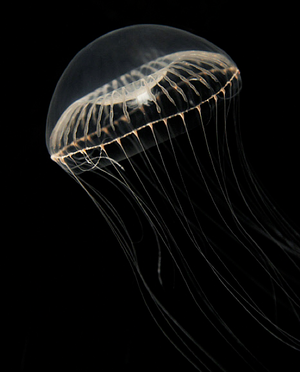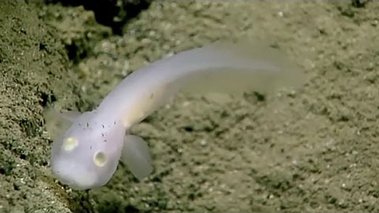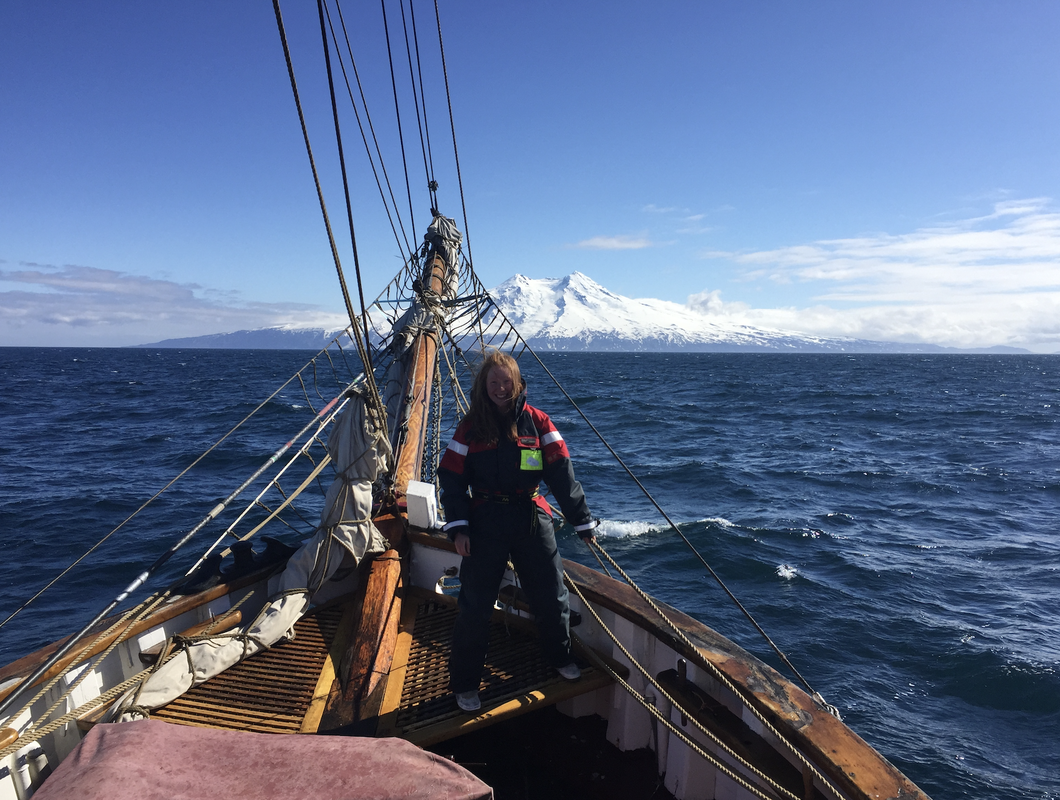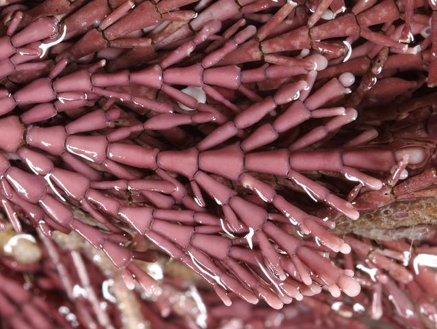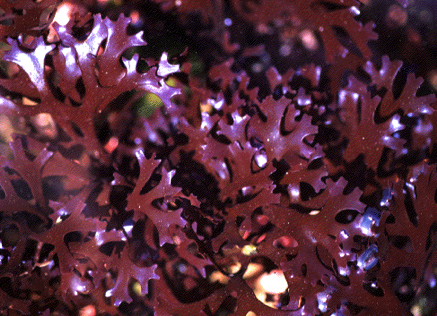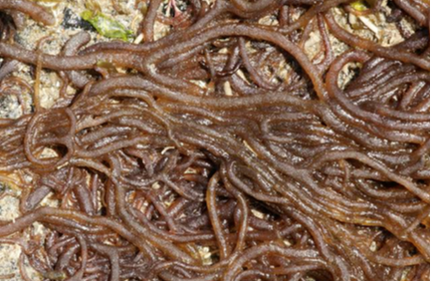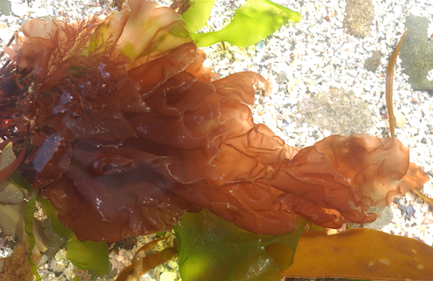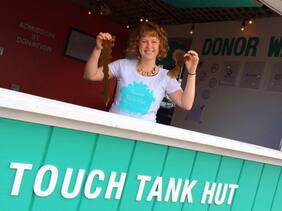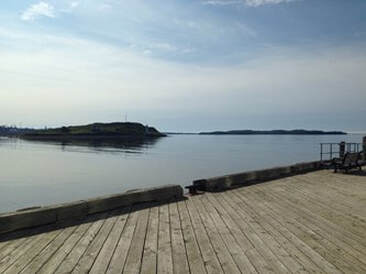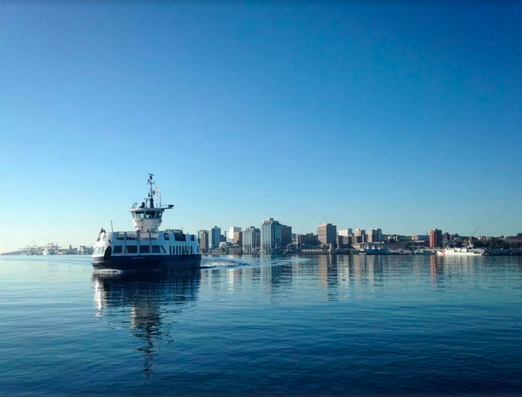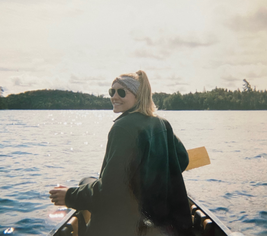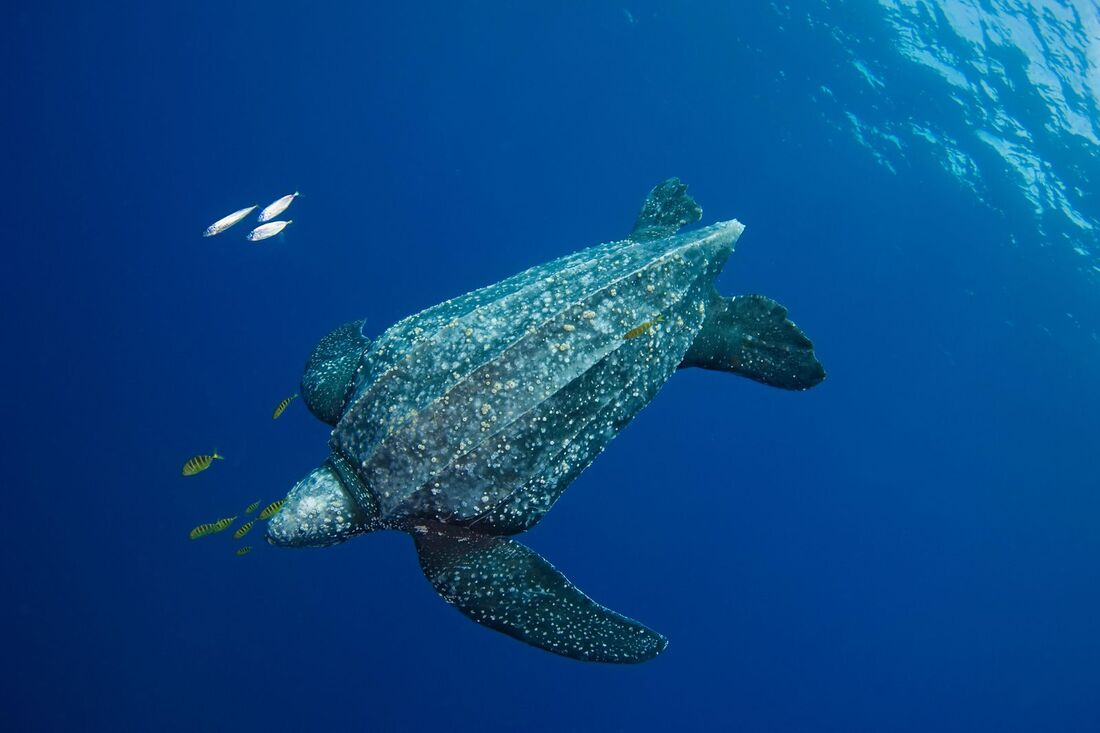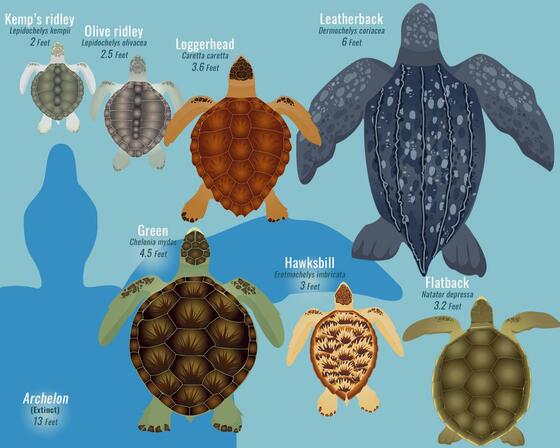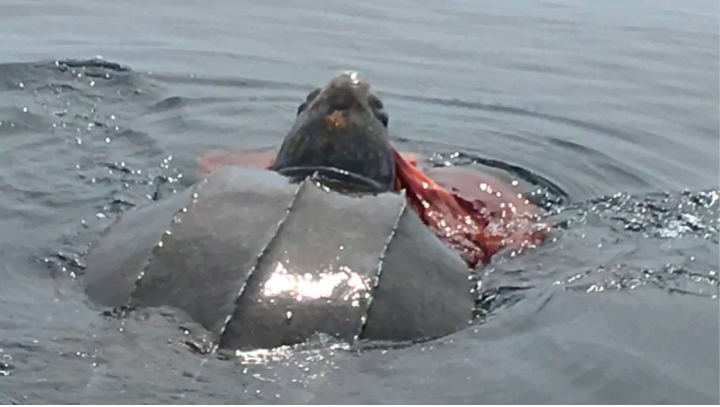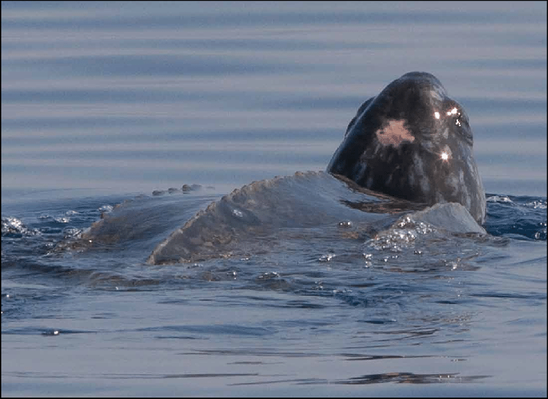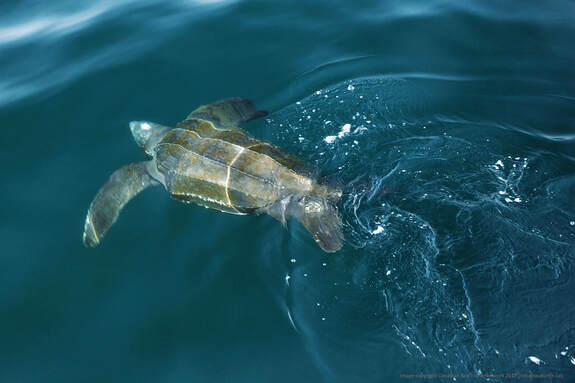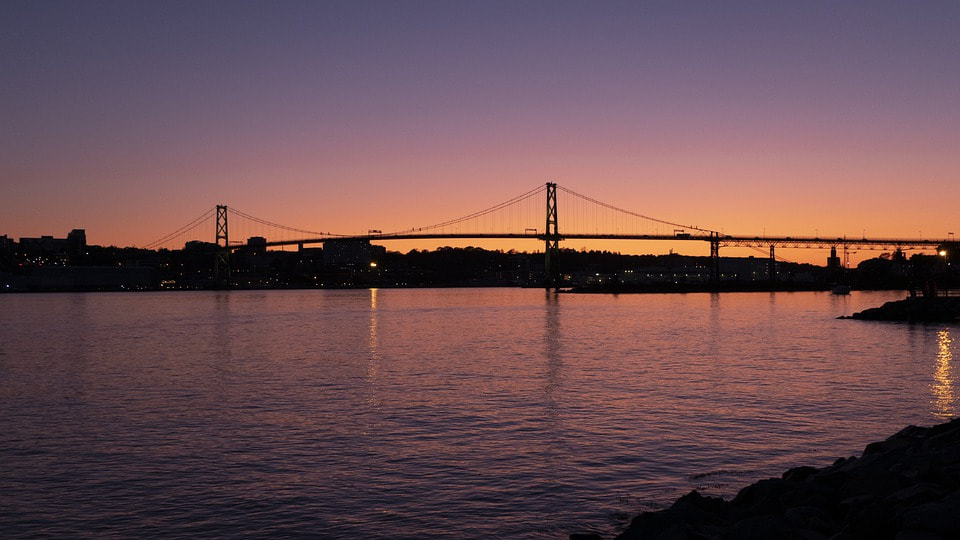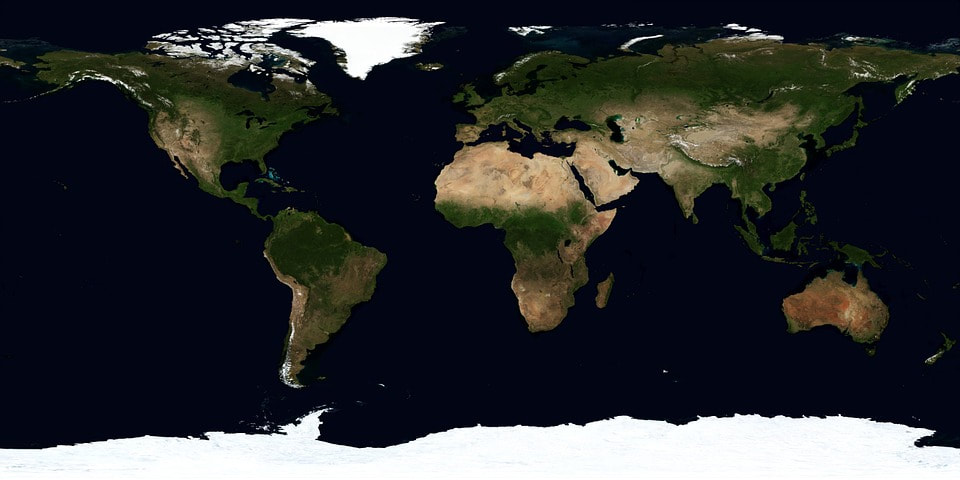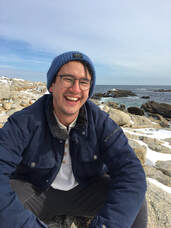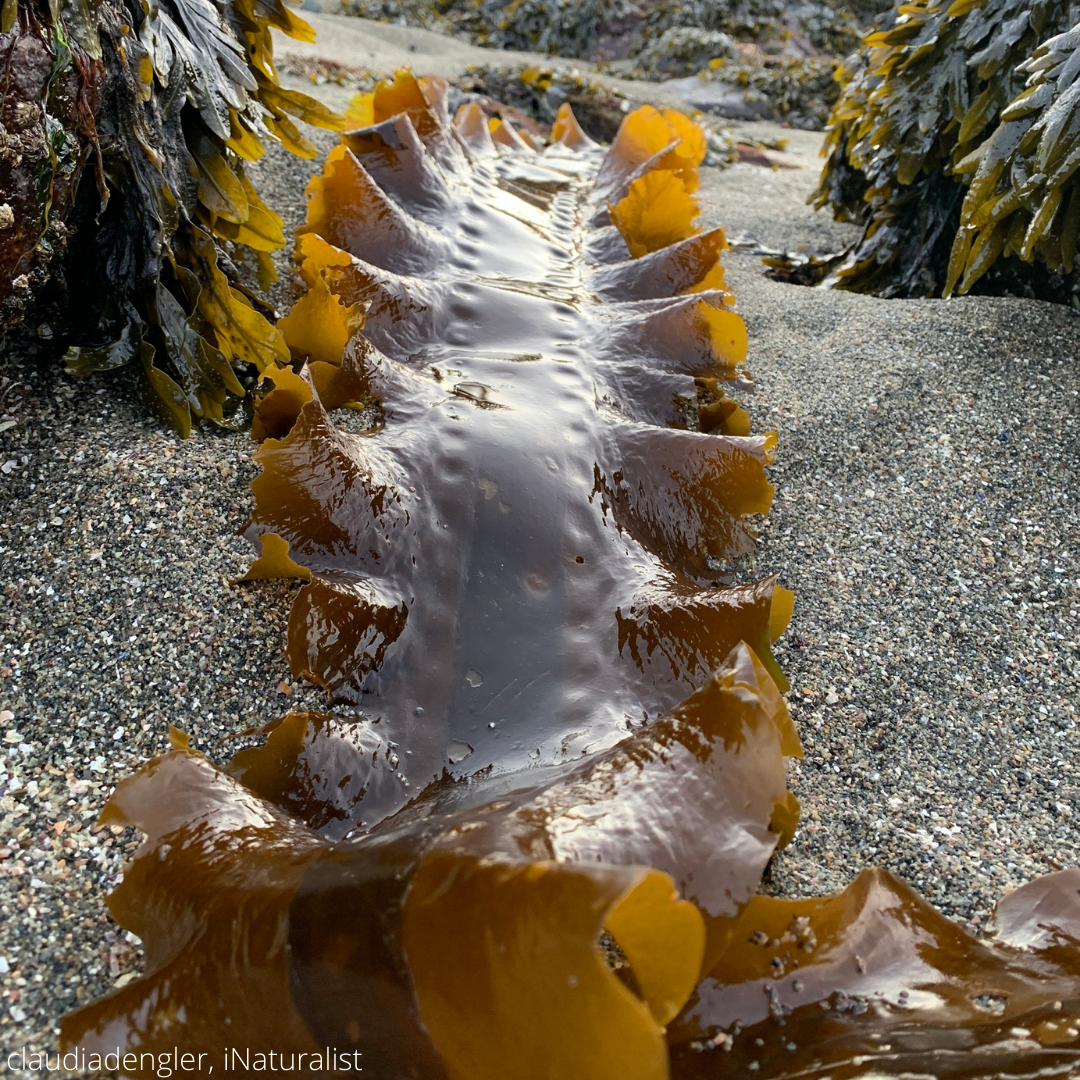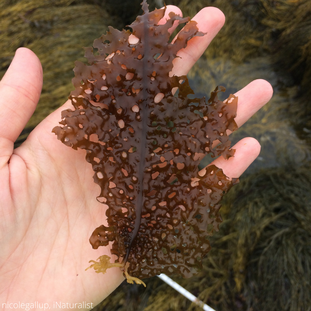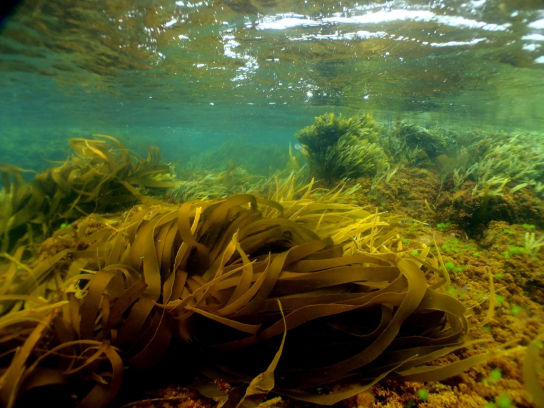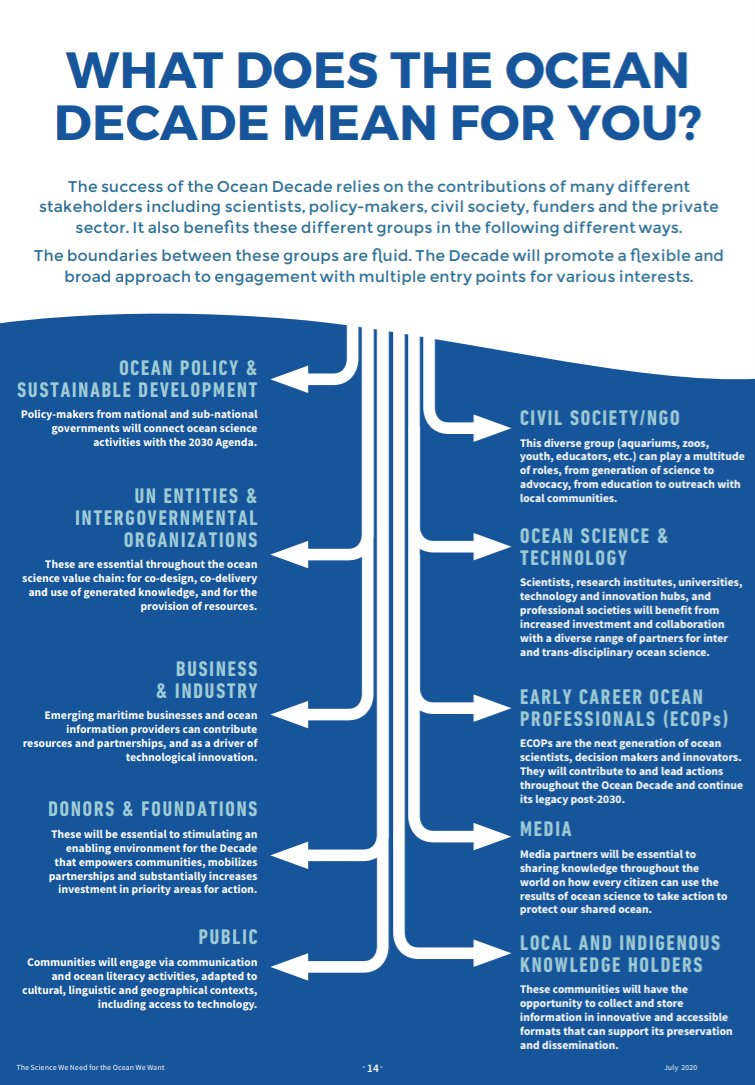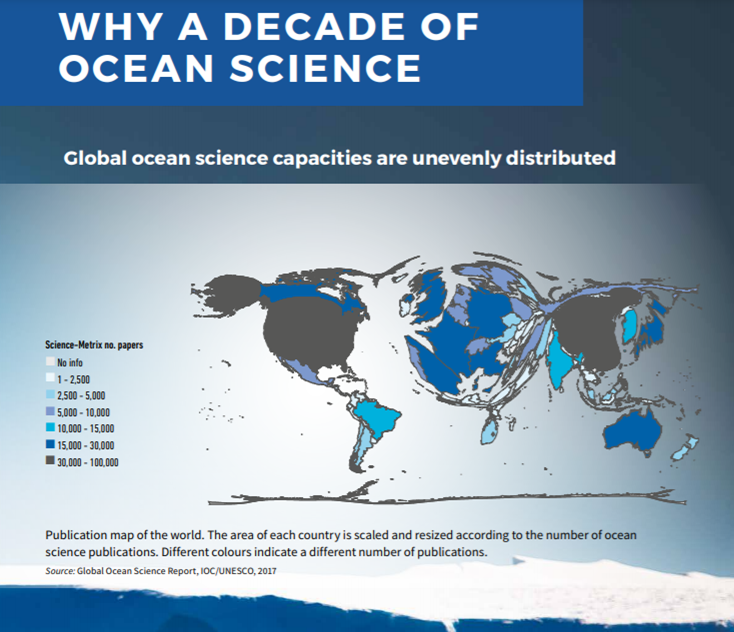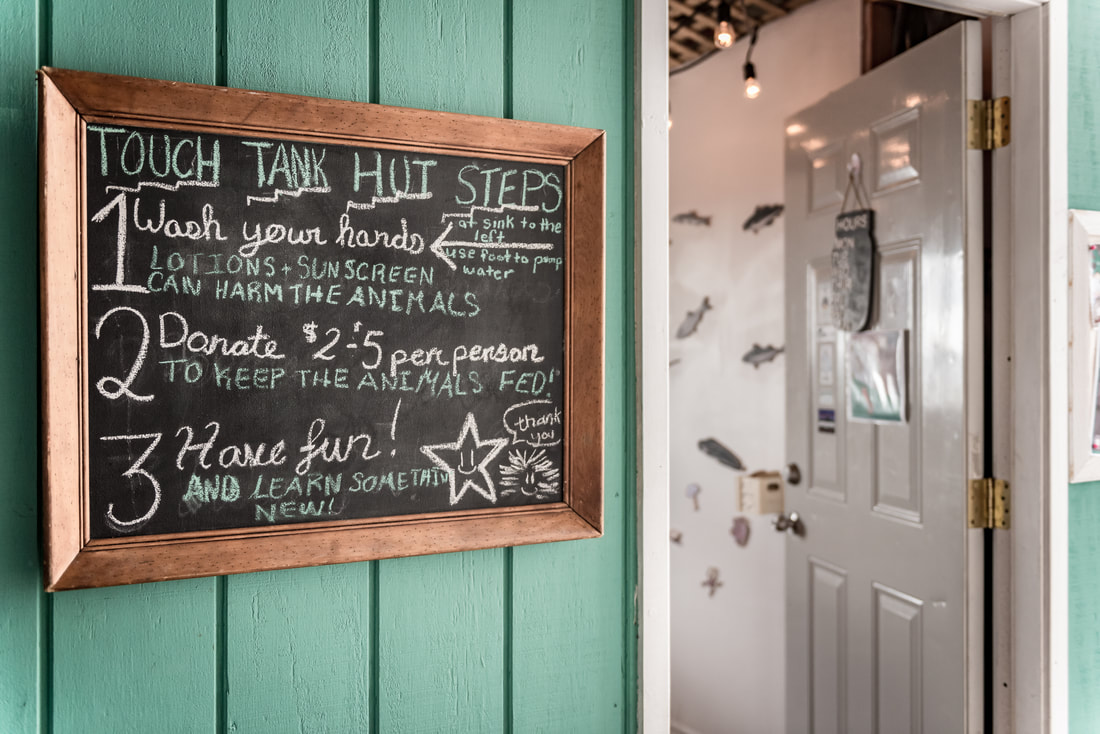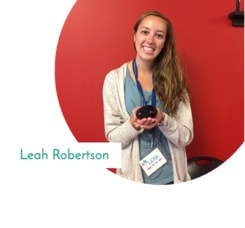|
by Kaitlin Burek “I spy, with my little eye, something that is green” is a difficult prompt at the best of times but is especially difficult on St. Patrick’s Day. If asked, my guesses would be: 1.The dog bed in my living room 2.The apples in my fruit bowl 3.The green algae in my vase of tulips In fact, green algae (Chlorophyta) would almost always be one of my guesses as you can “spy it” everywhere: lakes, rivers, ponds, oceans, soils, snow, lichens. The diversity in habitats lends itself to a wide diversity of green algae species. Estimates suggest there are between than 7,000-10,000 species worldwide making green algae the most diverse of the algal groups (catch up on Rhodophyta/red algae and Phaeophyta/brown algae)! Check out some examples of green algae species below. Oyster Thief (Codium fragile) Desmid (Micrasterias) Sea Lettuce (Ulva lactuca) Mermaid’s Tresses (Spirogyra) All photo credits: Kaitlin Burek Although green algae can be a nuisance to some – coating docks, clogging filters, stinking-up shorelines, creating blooms – it should be celebrated by all. Green algae serves as a vital food source for many aquatic organisms (e.g., snails, turtles) and creates a lot of the oxygen we breathe. Not only that, it also serves as a great St. Patrick’s Day challenge: “I spy, with my little eye, green algae”
0 Comments
by Xinya Calhoun This past September marked my first time volunteering for the Back to the Sea Society. It also marked the first ever public Animal Release Party - and what a turnout! So many families and friends came out to the beach at Point Pleasant Park to give our sea creatures some love and say goodbye to them one last time. It was an amazing experience that I’m sure will live on in everyone’s memories for years to come! Tons of families and friends came to Point Pleasant Park for the first Animal Release Party! All Photo Credits: Julie Balasalle As the Touch Tank Hut season ends each year, the animals have to say farewell to their summer home and return to the ocean. In 2021, we decided to give them an event that everyone could celebrate! Magali (Back to the Sea's Executive Director) and I spent almost an hour carefully packing up all the animals from the 4 tanks - crabs, sea stars, snails, anemones, you name it! We moved them from the tanks into bags of water and then into coolers so they stayed cool and comfy during the trip from the Touch Tank Hut to Point Pleasant Park. Our awesome staff and volunteers getting ready for the party! At the beach, we met with other Back to the Sea staff and volunteers. We had lots to do to set up, so it was great to have so many helping hands. Everyone pitched in to unpack, prepare the shell painting station, and get the animals ready to be handed out. Once people began to arrive, the party officially started! Each participant filled their reusable container with some water from the beach, and then lined up to get some animals! When an animal was chosen to be released, we made a note of it - it was important to keep track of each animal to make sure they all safely got to the ocean. Participants got to touch and hold the animals, and often got to learn some fun facts about them! Then the animals were put in their container and carried to the ocean for the participant to say a final goodbye and release them into the water. Though most of our species were intertidal and were content to be set free in the shallows directly by our participants, there were some animals (our moon snail Otis, for example) who needed to go a bit deeper to be happy. We had two brave snorkelers and an amazing diver swimming in the chilly waters to help make sure those species got far enough away from shore. A family getting their first animal - a sea star! We had so many animals to go around that many participants came back after letting their first one go so they could help release even more! Many kids also enjoyed the oyster shell painting station. Releasing animals back into the water! This animal release party is unlike anything I’d ever done before. It was hours of learning, sharing, and experiencing new things about marine animals while having lots of fun at the beach. I loved every second of it, and I hope that every visitor had as much fun as I did!
As we settle into winter here in Nova Scotia, I often find it hard to believe that our grey, frozen province can be the same place it was during the sunny summer months. It’s on these chilly November days that I like to look back to the time of sunshine – so what better time than now to reminisce about the Back to the Sea Society’s Touch Tank Hut season! This summer was a big one for the Touch Tank Hut building. After being closed for the entirety of the previous season due to COVID-19 and being moved across the parking lot of Alderney Landing, the Back to the Sea staff had a whale of a time giving the building some much needed TLC. Watching the Touch Tank Hut come together was truly an incredible sight! Once the building was in back in order and our animals collected, we knew we were officially ready to welcome our visitors. We had to make sure that the outside was looking as good as the inside! It’s amazing how much stuff can fit into a one-room building! Thankfully we were able to sort it all. Just your average day at the Touch Tank Hut! Speaking of visitors, we were so happy to welcome every single one of the 1,681 people who came through our doors this summer! People young and old were able to experience not only the Touch Tank Hut’s animals, but also the outdoor programming we developed this summer season. We loved being able to take visitors outside to paint shells, learn about coastal geology, make mini scuba divers, and clean up oil spills! Outdoor programming was a new adventure for us, and one we’re very happy to have done. The Touch Tank Hut is for everybody, no matter how small! Shell we Paint?! was definitely our most popular program! We loved seeing everybody’s creative sides as they painted their oyster shells. Our work didn’t just stay at the Touch Tank Hut, however. Our interpreters not only visited summer camps throughout the season, but we also ran Tidal Trekkers, the intertidal exploration program that we started as a COVID-19 pivot but proved so popular we had to bring it back! I had some of the best moments of my summer splashing through the shallow waters of the North West Arm and McCormacks Beach alongside curious visitors, finding the intertidal species I cared for every day at the Touch Tank Hut in the wild. It was awesome to be able to take our critters to summer camps! We’re so happy that you all enjoyed Tidal Trekkers enough to have us bring it back! Another reason the Touch Tank Hut had such a great season is due to our amazing staff! Back to the Sea was able to hire 5 staff this summer, including our Executive Director Magali Grégoire, Animal Care Lead Sarah Holleran, Volunteer Coordinator Maka Ngulube, Interpreter Lindsay Wamboldt, and myself, the Communications Coordinator. This amazing group of staff truly made the summer, and I’m so happy I got to work with all of them. Ladies, if you’re reading this: cheers to an awesome season! The dream team! From left to right: Lindsey, Maka, Magali, Sarah, and Sarah. Even though it’s cold and grey outside right now, the memories of this summer at the Touch Tank Hut serve to remind me that someday, in however many months, the sun will be shining and the Touch Tank Hut will be open once more. Until then, however, memories will have to do!
With an estimated one million species of animal living in the ocean, the diversity of ocean life is truly amazing! While most of us might think about sea turtles, dolphins or the biggest sea creature of all, the blue whale, as our favourite underwater wonder, not every species in the ocean is quite so… photogenic. Most of the spookiest sea creatures live deep beneath the ocean surface, where the sunlight barely reaches. This environment houses some of the most interesting and ugliest(!) animals that have only recently been discovered by scientists due to the remarkable conditions where they exist and thrive. This spooky season, we want to share with you some of the spookiest sea creatures! Be brave and dive into our top ten list! 10. CoffinfishCoffinfish, colloquially known around Australia (where they are most commonly found) as Sea Toads, are benthic (bottom-dwelling) fish with the ability to use their fins to walk along the seafloor! They are ambush predators, whose facial expressions typically look really sad, because of the shape of their mouths. However, they are able to inflate their body with water which allows them to hold their breath for up to four minutes!! This is supposedly so that they can conserve energy when food on the ocean floor is scarce. And when they do… they look kind of like a cute balloon?! (Photo credit: National Geographic) 9. Sarcastic Fringehead Although completely harmless to humans unless provoked (they have been known to threaten scuba divers who get too close…), the Sarcastic Fringehead is well known for opening its huge mouth to fend off other ocean-dwelling critters when provoked or agitated. They live in burrows or tube-like structures created by other animals, such as burrowing clams or snail shells. Their specifically-designed jaws fan out to the side when they open their mouths, which makes them appear much larger and more intimidating. If one Sarcastic Fringehead challenges another, the two will “kiss” by aggressively pressing their open mouths against each other until one finally gives up and swims away! (Photo: WikiMedia) 8. Barreleye This deep sea fish is transparent and has the ability to move its eyes 360 degrees so they can see what’s going on (and what’s for dinner) even when it’s behind them! Scientists only fully discovered this species in 2009, when they identified that their eyes can fully rotate inside of their head. Another quirky trait of the Barreleye is that it engulfs its prey fully! The Barreleye, like many species on this spooky list, lives deep in the ocean where there is hardly any light, so their specially designed eyes allow them to see even in almost complete darkness. (Photo: MBARI) 7. Vampire Squid Unlike other squid (which can be surprisingly aggressive as tiny sea critters go!), Vampire Squid are surprisingly docile (no, they don’t suck the blood of their prey!). Vampire Squid actually feast mainly on “marine snow”, decaying organic material that falls down to the ocean floor. The spookiest feature of the Vampire Squid is its strange appearance, notably it’s umbrella-like tentacles! (Photo: ThoughtCo) 6. Goblin Shark You guessed it, these guys are ugly. Nonetheless, they use their impressive ugliness to their advantage; they use their elongated, flattened snout to seek out their prey with specialized sensing organs to sense electric fields in the darkness of the deep ocean, and they can extend their jaw the entire length of their snout to catch their prey (mainly squid, fish and crustaceans) with their 50 thin, sharp teeth! Thankfully they only grow to be 8-11 inches long! (Photo credit: Diane Bray, Museum Victoria) 5. Northern Stargazer Only found in the eastern United States, this frightening fish burrows itself in the sand to camouflage and can use its side fins as shovels to quickly burrow and hide beneath the sand. When unsuspecting prey comes near, the stargazer has a special organ on its head that can deliver an electric shock that stuns and confuses the prey and electrically shocks it into submission. Seems like not only is this guy pretty painful to look at, but might be pretty painful to encounter on the bottom of the ocean... (Photo: Huffington Post) 4. Deep Sea Anglerfish Yet another deep-sea carnivore, this anglerfish, also known as the humpback anglerfish, has to be one of the ugliest and spookiest creatures on the planet! Most famous for the bioluminescent growth on their heads, which lures their prey towards them, and to their death, deep in the darkness of the ocean. This lure is filled with bacteria, which the fish use to make their own light. They use a muscular flap of skin to either expose or hide the glowing lure. Pulsing the light and slowly moving it back and forth attracts all kinds of prey. Creepy, right? Not to mention their razor sharp, translucent teeth and their dead-looking eyes... (Photo: Oceana) 3. “Flying Spaghetti Monster” Bathyphysa conifer Belonging to the Siphonophores, a group of animals including corals and jellyfish, is probably one of the weirdest creatures floating around in the ocean; first captured on video by oil and gas workers in 2015, at around 1220m depth. It has been nicknamed the “flying spaghetti monster” for its white, noodle-like appearance. Perhaps the quirkiest fact about these guys is that Siphonophores actually clone themselves in order to grow! Instead of a single body, one siphonophore is a whole tightly knit colony of many organisms, sometimes several thousands! (Photo: National Oceanography Centre) 2. Skeletal Jellyfish Also known as the crystal jellyfish, this ghostly, translucent critter can give off a green-blue glow when provoked or disturbed, due to the 100 or more tiny, light-producing organs that surround its outer bell. Glow in the dark and a skeleton costume? This guy is permanently embracing spooky season down there on the ocean floor! (Photo: Hiroya Minakuchi) 1. Ghost Fish Perhaps not as terrifying as some of the others, but by far my favourite spooky sea creature is this little guy; the ghost fish! Spotted alive and swimming for the very first time by a team of NOAA research scientists in 2016, we are still learning all about the ghost fish, which was seen swimming in the Mariana Trench at around 2500 m depth!! With translucent, scale-less skin and small colourless eyes, the ghost fish is undeniably bizarre and gives me perfect spooky season vibes! (Photo: Weather Channel)
When most individuals “see red”, they are getting angry. When I “see red”, I am getting excited because I probably just spotted red algae (Rhodophyta)! Unlike the brown algal species described here, red algae contains a pigment called phycoerythin which absorbs blue light and reflects – you guessed it – red light. The more phycoerythin a species has, the redder it appears. What local, Nova Scotian red algae species below do you think has the most phycoerythin? Corallina officinalis Chondrus crispus Nemalion helminthoides Porphyra Not only does the colour differ, but there are other morphological (or the way something looks) differences between these four red algae species. You may have noticed, for example, that Corallina looks hard and articulated whereas Porphya looks soft and sheet-like. Perhaps it was the ooey-gooey, worm-like Nemalion that first caught your eye or the branching Chondrus. Whatever it was, I am sure you’d agree that there is a lot of morphological (there’s that word again) variation between these four species. Now, what would you say if I told you there are more than 6,000 species of red algae? Although there are morphological differences galore amongst red algae, there are also differences in how species are used by us! Would you believe me if I told you certain Corallina species are dried and used as a bone-forming material? It’s true! Chondrus crispus’s use is equally mind-blowing: did you know that it is harvested and used in Jell-O, ice cream, and vegan gelatin? It’s true! What about Porphya? It’s true that Porhyra is used in sushi! What about Nemalion, did you know it is harvested by aliens to make spaghetti? Okay, maybe that last one isn’t true. Regardless of what it looks like or what we use it for, I hope that you get excited the next time you “see red”. Tune in next time for when we explore green algae!
Imagine a motorcycle revving through your house while you get ready for school, make a meal, or talk to your family. That motorcycle would be loud, kick up dirt everywhere, and make it difficult to do the things you normally do. No one signs up for that! That is a taste of what marine creatures in the Halifax Harbour have been experiencing for decades. Big container ships, recreational boats, and ferries drive through their living rooms, making lots of noise and polluting their space. Fortunately, the Halifax Harbour will be changing soon! However, before we talk about the good things coming our way, we need to talk about why things need to change – we need to talk about how animals in the Halifax Harbour are affected by noise pollution. Halifax Harbour on a still morning (image credit: Charlotte Craig) Whales are heavily impacted by boat noise, because they use echolocation to find their food and move around the ocean. Echolocation is when animals like whales and dolphins send out sounds in the water, and listen for those sounds to echo back to them, helping them figure out what is around them. While whales are rare visitors to the Harbour, some more common creatures are affected by noise, too. Animals that you see in the Touch Tank Hut like crabs and urchins can also be affected by noise. Noise pollution can reduce all marine creature’s ability to communicate, navigate, locate prey, avoid predators, and find mates. Ecological acts that are key to ocean health that are performed by invertebrates, such as water filtration and mixing sediment layers, are also negatively affected by noise. Overall, noise stresses animals out and it stops them from doing all the things that they normally would. Boats can also cause silt (ocean floor dirt) to be turned up which can make moving around very tricky. Boats can also leave behind unwanted fuel and other pollutants while they move through the water. Thankfully, our sea friends will soon be catching a small break. Electric ferries are coming to the Halifax Harbour starting in 2022. Electric ferries are quieter and don’t use gas. Hooray! A Halifax Harbour ferry (image credit: Discover Halifax) The new ferries will run on a new route from the Halifax terminal to a new terminal in Mill Cove. While it is only a small step in the right direction, hopefully it will lead to the province adopting more electric ferries and other transportation. Maybe one day, the Halifax-Alderney route will be electric, and the Touch Tank Hut residents will be spared the noise. Just as we must wash our hands and keep our voice down in the Touch Tank Hut, it’s about time we start keeping the water clean and quiet for out ocean buddies in the Harbour! June 16th is World Sea Turtle Day! To celebrate, let's talk about a sea turtle that’s a bit closer to home than you may have realized. Canadian Sea Turtles When you picture a sea turtle habitat, I bet you’re picturing a lush tropical beach with crystal clear turquoise water. That’s not incorrect! We can find many different sea turtle species in the tropics. However, there is one special species that likes to visit Nova Scotia’s waters on an annual basis. Welcome to the wonderful world of the leatherback sea turtle! The presence of leatherback sea turtles in Nova Scotia is a relatively new finding in the scientific world, although fishermen all across Atlantic Canada reported sightings of these turtles long before the first scientific article was published. Named after the thick skin that covers their shells, leatherback sea turtles visit Atlantic Canada and the North Atlantic ocean as part of their migration route. They can be spotted in Atlantic Canadian waters during the summer months, and then during the fall they begin their journey back down to the tropics to mate and nest. Leatherbacks are Super Cool Not only is it awesome that Canada has its own sea turtle species, but we actually have (in my opinion) the most fin-tastic sea turtle! Although there are many reasons as to why the leatherback is so incredible, I’m going to highlight three of my favourite reasons below. Their Size Size comparison of all seven currently living species of sea turtle, and one extinct species. Photo credit: Smithsonian Not many people realize just how big sea turtles are. Green sea turtles, which are a popular tropical sea turtle species and sometimes found in Atlantic Canada, are typically 3 to 4 feet long and weigh over 300 pounds. This is similar to the size of a baby elephant! However, Green sea turtles have nothing on leatherback turtles. Leatherback sea turtles are actually one of the largest reptiles on earth! They can reach over 2 meters (6 feet) in length and weigh over 2000 pounds. The only reptile to come close to the size of a leatherback sea turtles is the salt water crocodile! What They Eat Leatherback eating jellyfish in Atlantic Canada Photo credit: Lorne Bonnell from CBC news Leatherback turtles do not have a very diverse diet. In fact, they mainly only eat one thing. Based on how big they are, be you may think they eat huge fish or full lobsters – but the reality is a bit more strange! Leatherback sea turtles follow currents from the tropics all the way to Nova Scotia to find one thing: Jellyfish! You read that right, these massive turtles only eat jellyfish and other jellyfish-like animals like tunicates and ctenophores. A single jellyfish doesn’t provide very much nutritional value, so leatherback sea turtles will eat up to their body weight in jellyfish every day! Think about how many more jellyfish would fill our ocean if we didn’t have turtles eating 2000 pounds of jellyfish daily. Thank you leatherbacks! The Pink Spot Leatherback sea turtle with visible pink spot on the top of its head! Photo credit: S. Bonizzoni The last cool leatherback fact I’m going to highlight is their pink spots. Leatherbacks have a very special characteristic that helps us identify them from afar (it comes in handy when trying to spot a leatherback from a boat to tag!). On the back of every leatherbacks head is a pink dot. This is actually an exposed part of their brain! Although science is still debating what the actual function of this pink spot is it is theorized it helps identify light and may play a role in leatherback migration! Perhaps a built in GPS? Turtles in Danger Unfortunately, similar to other sea turtles species, leatherback sea turtles population numbers have declined, and the species is currently listed as vulnerable on the IUCN Red List. These turtles face many threats including fisheries bycatch, habitat loss, and plastic pollution. On the plus side, if you’re looking to help leatherbacks you have already have helped just by reading this far into my blog post! Not many people realize how cool leatherback sea turtles are and that they are part of our maritime family. The more people that realize these turtles share our waters and how amazing they are, the better chance the turtles will have for future protection measures. If you are interested in doing more for leatherback sea turtles check out the Canadian Sea Turtle Network who are doing great work for sea turtles in Canada. If you’re looking for even more leatherback content checkout this fact page by NOAA Fisheries. Feel free to ask questions about leatherbacks in the comments! 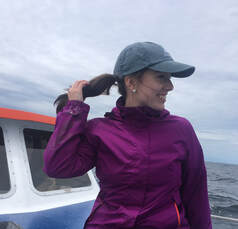 Lauren is a part of the Communications Committee for Back to the Sea and just recently finished her undergraduate degree in marine biology and sustainability at Dalhousie. Lauren is extremely passionate about ocean conservation and loves to share this passion by educating everyone around her on the wacky and amazing species that call the ocean home! June 8th is World Oceans Day—or, depending on who you ask, World Ocean Day. Why is there a debate? Surely, in an age where thousands of satellites orbit the Earth, we know how many oceans there are? But it turns out, it’s a little more complicated. 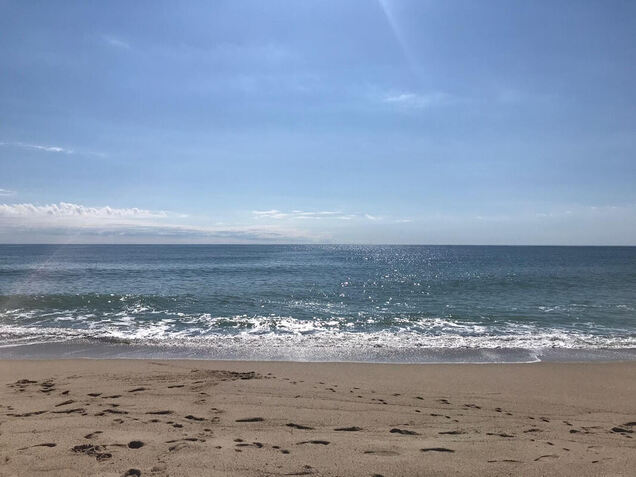 The ocean as seen from a beach Let’s start close to home. If you’ve visited Back to the Sea’s Touch Tank Hut at the Dartmouth Waterfront, then you’ve probably seen the ocean while you’re there—it’s the big blue thing right in front of you! You can’t miss it. Here in Nova Scotia, we live next to the Atlantic Ocean. Canada borders three different oceans: to the west is the Pacific, and up north is the Arctic. But how many oceans are there in the world? Halifax harbour at sunset, showing the Macdonald bridge If you listen to Eurythmics or are a pirate from the olden-times, you might have heard that there are “seven seas”. What exactly are they? That rather depends on who you ask, and when. First of all, even though “seas” and “oceans” are often used interchangeably, geographers make a distinction: seas are smaller and are often partially enclosed by land. Secondly, many different cultures and eras used “seven seas” as a catch-all term for the waters that extended towards the limits of their known world. For the ancient Persians, the “seven seas” were actually rivers and in Central Asia. It wasn’t until Europeans began exploring the world that the seven seas came to include the oceans as we know them today. Map showing all of the world's oceans So, let’s count the oceans and see if they add up to seven. We already know three of them: the Arctic, the Pacific, and the Atlantic. The fourth ocean is the Indian Ocean, located between Africa, Asia, and Australia. And that’s where the list ends—for some people. Others recognize a fifth ocean surrounding Antarctica called the Southern Ocean. In 2000, the International Hydrological Society—the global authority on nautical charts—proposed a new boundary for the Southern Ocean. But it was never ratified by all the member states, so its “official” existence remains up in the air, and some maps don’t include it. As the previous example makes clear, the reasons why we create boundaries between oceans can sometimes be a bit arbitrary. It’s hard to say exactly where one ocean ends and another one begins. Even though we talk about different oceans and seas, all the water in the ocean is connected, although it can take a very long time--up to 1,000 years—for a parcel of water to make its way from end of the ocean to another. That’s why some people think we should call it World Ocean Day: to remind ourselves that there’s only one big, interconnected ocean that we’re a part of, too. The ocean is complicated—and people make it even more complicated. No matter which way you to choose to celebrate, Ocean Day or Oceans Day, I hope you take some time today to think about the incredible waters that make up 71 percent of our planet and how we can protect them. "April showers bring May flowers”. A hopeful expression that is heard and repeated by many in Atlantic Canada as we collectively say goodbye to the winter and get excited about the summer. A lesser-known expression with similar sentiments is “When spring winds are a-blowing, kelp are actively growing”. Okay, I may have made up the expression, but the information within is true – spring is the time when most kelp grow most actively! The term ‘kelp’ refers to a mix of brown algal species that can be recognized by their large blade (leaf-like structure), long and strong stipe (stem-like structure), and anchoring holdfast. Some examples of kelp species found in the coastal ocean around Nova Scotia are Lasagna Kelp (Saccharina latissima), Colander Kelp (Agarum clathratum), and Oarweed (Laminaria digitata). Which drawing do you think matches each kelp name? If you guessed (from left to right), Lasagna kelp, Oarweed, and Colander kelp, you’re right! These are all kelps you’re likely to find washed up along our Nova Scotia coast, so keep an eye out for them on your next beach walk! Kelp is one of the fastest growing seaweeds in the world and Nova Scotia kelp can reach upwards of 10 metres in length: to visualize, a standard school bus is 10 metres long. Some species around the world can grow up to 60-centimetres in a single day! Kelp grows so large and so quickly by using photosynthesis to produce sugars, just like land plants. Unlike land plants who gain nutrients through their roots, however, kelps gain their nutrients directly from the surrounding water. Spring is a particularly wonderful time for kelp growth because these processes – photosynthesis and nutrient uptake – are working particularly well together. Photosynthesis, for one, is improved as light can reach the ocean floor largely unfiltered by suspended, blooming algae or by a canopy of larger kelp, as happens later in the summer. The availability of nutrients is also improved as wind and other upwelling-inducing events bring deep, cold, nutrient-packed water to shallow, kelp-infested waters. As they say, “When spring winds are a-blowing, kelp are actively growing”. Tune in next time for when we explore red algae! Learn more about one species of kelp, in Back to the Sea Society’s Lasagna Kelp (Saccharina latissima) Shell & Tell episode. 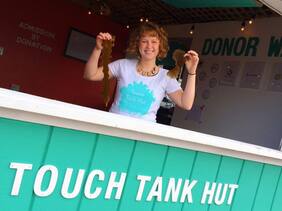 Kaitlin is a self-identified ocean lover and wannabe communicator who has been volunteering with Back to the Sea for years. Equipped with a degree in marine biology, she is an avid advocate for ocean literacy, curiosity, and stewardship and feels passionate about collaborating with others to make information available and accessible. Working by day and blogging by night, she aims to post about all the interesting, fascinating, and just plain weird happenings that occur in the ocean. By: Leah Robertson Scientists and conservationists around the globe did a collective jump for joy when the United Nations declared 2021-2030 to be the Decade of Ocean Science for Sustainable Development – the Ocean Decade for short. Now more than ever, we must work together to produce “the science we need for the ocean we want”. The ultimate goal is for scientists to work together fully support the United Nation’s Sustainable Development Goals by 2030. The United Nation has a multitude of organizations that have a stake in ocean development and sustainability. From the Intergovernmental Oceanographic Commission of UNESCO (IOC) to the International Seabed Authority (ISA), these organizations all oversee unique aspects to managing our world ocean. Together, they work to benefit future generations of humankind. Currently, global ocean science research is distributed unevenly. Some nations generate very low rates of scientific research compared to others, as shown in the photo below. Globally, ocean science only accounts for between 0.04% - 4% of total government research and expenditure. A goal of the Ocean Decade is to improve scientific capacity in regions which are presently limited in capability, as well as building up the amount of research worldwide. This global way of thinking is especially important, because even for landlocked countries the ocean is important for the health and survival of every person in the world. Source: “The Decade in a Nutshell” https://www.oceandecade.org For us at Back to the Sea Society, the Ocean Decade means better science and a continued effort towards ocean conservation. Throughout the year, and especially in the summers, we work to share our scientific knowledge with others. This is in the hopes that the more we know about the ocean, the more we will work to protect it. An Ocean Decade means more science than ever to share. We are excited to follow along in the developments and continue to make our own contributions to ocean literacy and education! Photo: The sign outside of our Touch Tank Hut Want to learn more about the Ocean Decade? Check out this link!
|
Categories
All
We send blog recaps with in all our quarterly newsletters!
|
